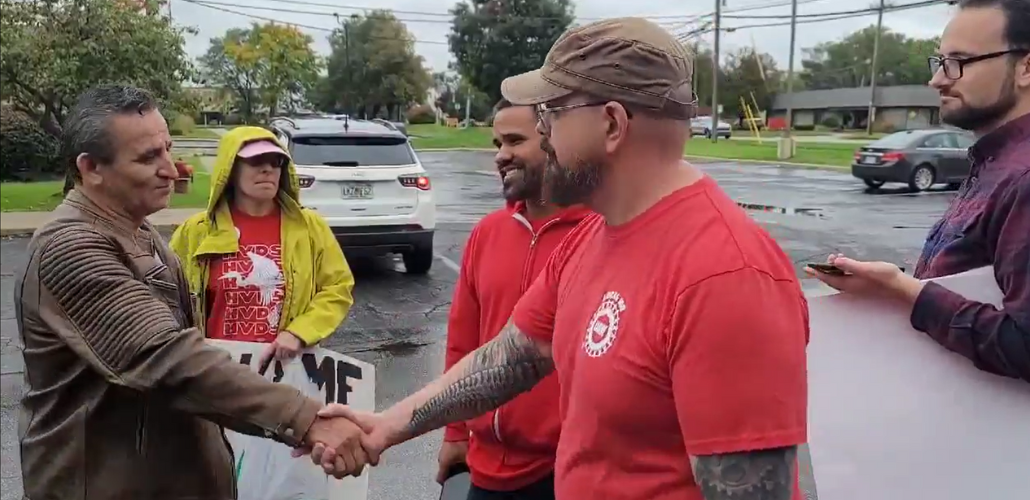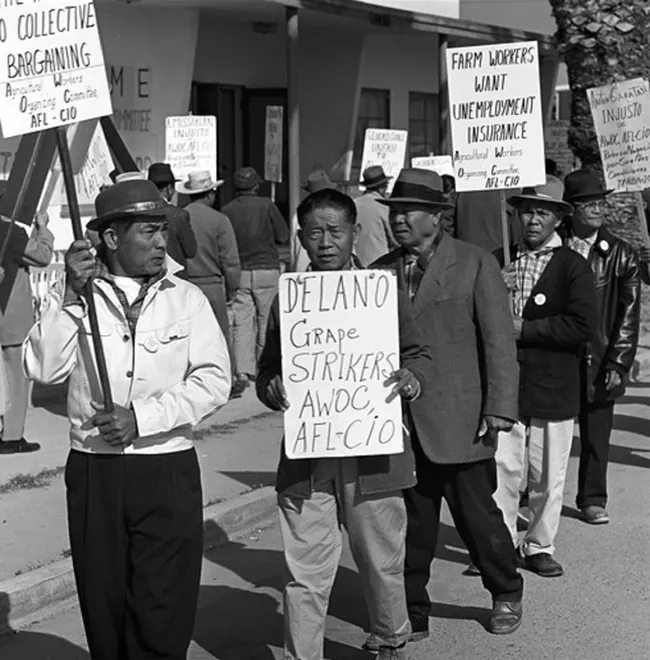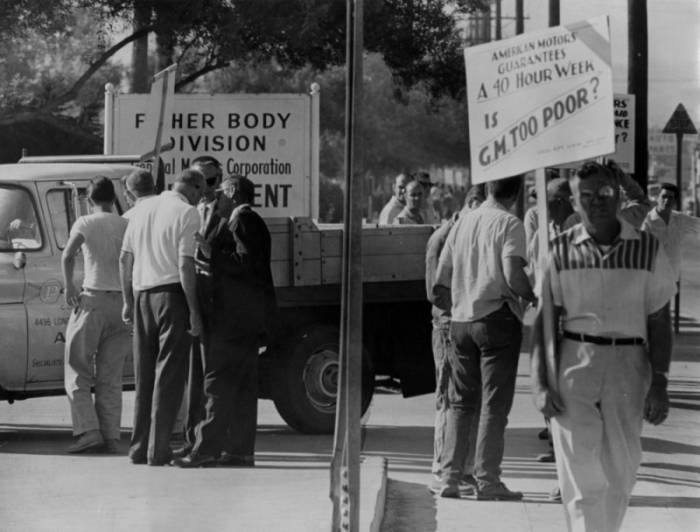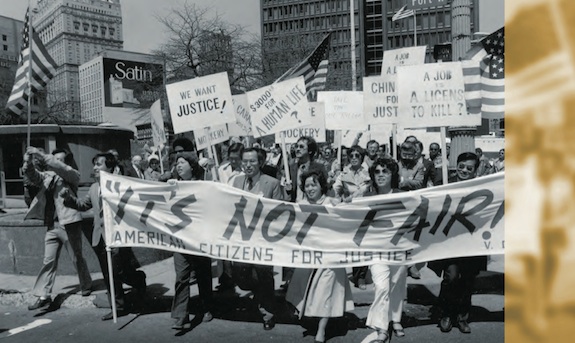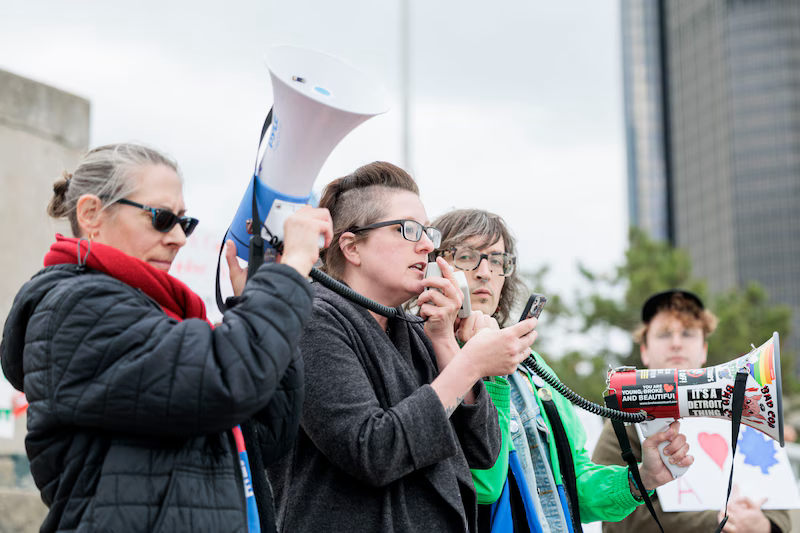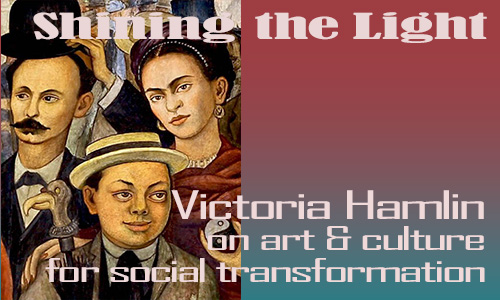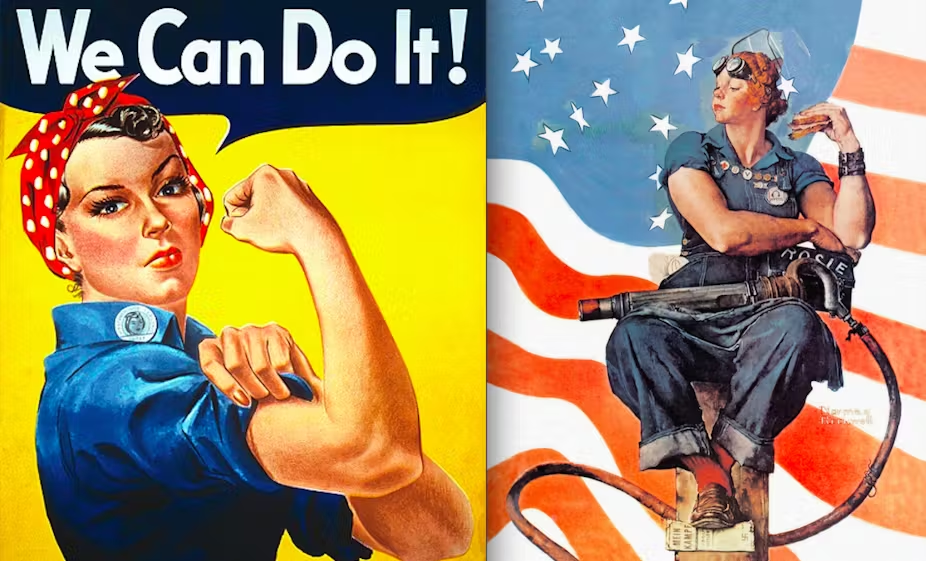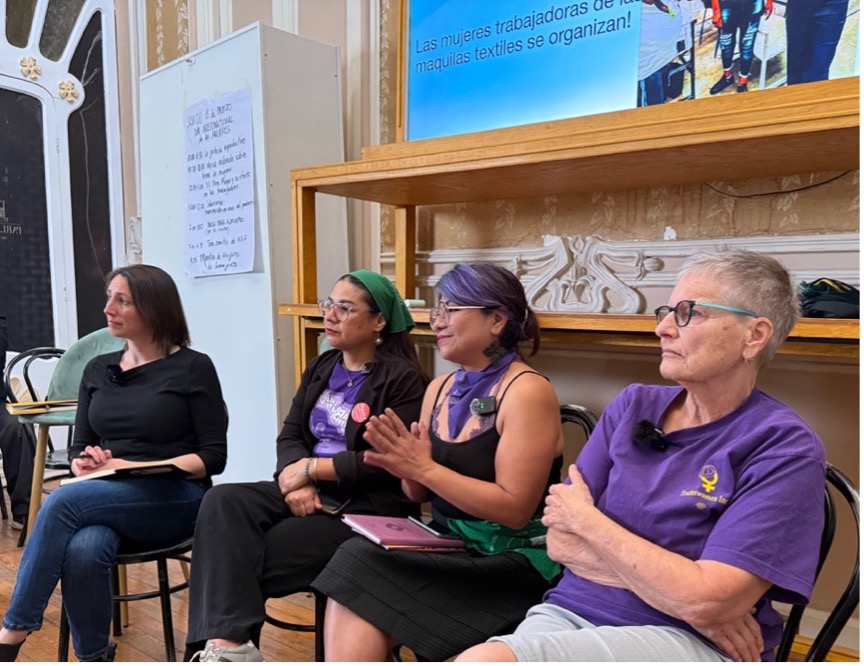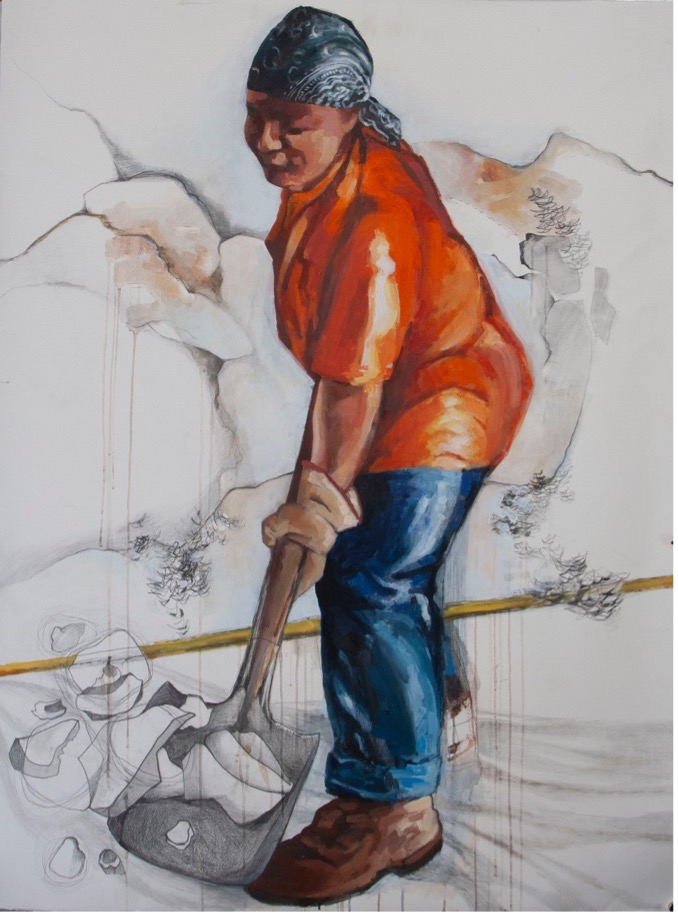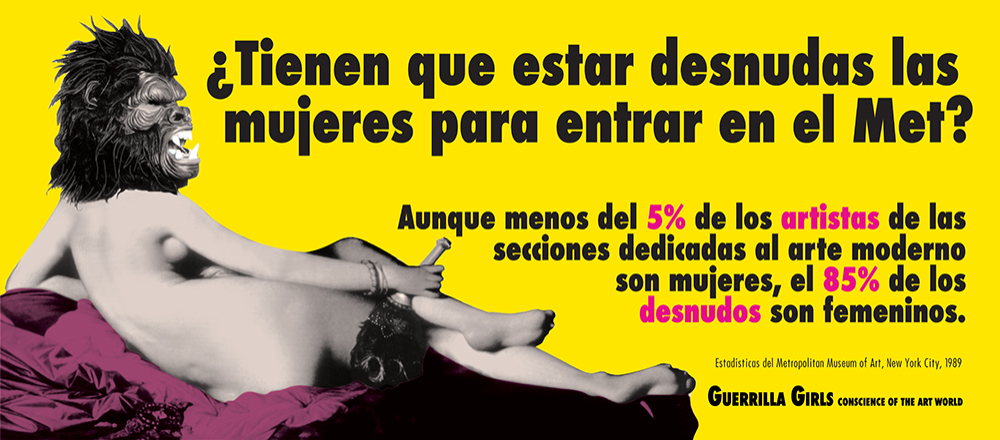|
|
The weekly newsletter of the Mexico Solidarity Project |
|
Every issue archived online at mexicosolidarityproject.org/archives/ |
|
April 30, 2025 |
|
|
|
Autoworkers on May Day: Divided by Tariffs? |
|
Meizhu Lui, for the editorial team |
|
|
US auto worker Sean Crawford (r, in hat) thanked Mexican auto worker Israel Cervantes (l) for his solidarity when they met in 2023. Cervantes and other Mexican GM workers refused overtime when GM workers in US struck in 2019. Labor Notes, April 02, 2025 / Sean Crawford |
|
This May Day, when workers around the world rise to demand rights, respect and their just share of the wealth, autoworker solidarity is on the line.
“I always say ‘tariffs’ is the most beautiful word to me…It’s going to bring our country’s businesses back,” declared President Trump. That sent alarm bells ringing for Mexican and Canadian autoworkers, who feared that if the cars they made were more expensive to export, the manufacturers would export their jobs instead. Conversely, it raised hopes for many US autoworkers that closing plants in Mexico and Canada might indeed bring those jobs to the US.
When Trump uttered his “beautiful word” like a wicked hex, it immediately threatened to tear apart what the autoworkers from the three countries should so urgently be reinforcing — their fragile unity.
It’s true that, in 1994, when NAFTA implemented “free trade” rules, US automakers moved plants to Canada and Mexico, and wages went down across the hemisphere. But over the past 30 years, the auto industry has changed. Auto production today tightly knits together workers in all three countries as they produce different components of the finished vehicle that rolls into your driveway.
Trump’s tariffs attempt to answer the wrong question. For US autoworkers, the question is not about the rules for a zero-sum game, where a set number of jobs are won or lost according to rules set by Trump. The real question is — How do we get good jobs for all?
Here’s an example of the way to go — cross-border support. In 2021, GM workers in Silao, Mexico refused overtime to make products needed by John Deere when UAW workers were on strike. The UAW returned the favor by helping those same Mexican workers, who were successfully organizing a fighting union, SINTTIA. When autoworkers win better contracts in one country, it shifts the “race to the bottom” into reverse.
Nor should our concern be only about existing jobs. The UAW recognized this when they won the right to represent workers in future EV battery plants. On the Mexico side, while Trump is looking backward, President Claudia Sheinbaum is looking forward. In response to tariffs, she has speeded up the use of government resources to build new industries in line with 21st century technologies.
Worker solidarity and advocating for the expansion of our economies, not fighting over the same few jobs, will make May Day great again. |
|
|
|
|
Today, we repost an interview with Mark Masaoka, a GM Van Nuys California who saw his own plant shuttered, devastating the lives of UAW workers. |
|
Working for GM: Past, Present, and Future |
|
Mark Masaoka was a leader of the UAW local union at the Van Nuys plant in California, where he worked as an electrician until the plant closed in 1992. While in the UAW, he participated in its national insurgent New Directions caucus. Always interested in expanding worker power, he currently supports Rideshare Drivers United, an independent union for Uber and Lyft drivers. A longtime advocate for the Asian American movement, Masaoka has remained active in the Asian American community and with the Democratic Socialists of America. |
|
|
How did you end up working at the GM plant in Van Nuys, and what made you become a union activist? |
|
|
Agricultural Workers Organizing Committee members picketing in front of Filipino Community Hall as part of the Delano Grape Strike on September 24, 1965. © Harvey Richards Media Archive |
|
I didn't know anything about unions. But I met Philip Vera Cruz, the person who inspired me to join working-class struggles. As a farmworker and Marxist, Vera Cruz organized his fellow Filipino workers into the National Farm Labor Union. In 1965, his local union in Delano, California, was the first to strike against the grape companies. Vera Cruz and Cesar Chavez joined forces to form the United Farm Workers Union after the companies tried to use Mexican workers to break the strike. The civil rights movement also radicalized me, as it radicalized other young Asian Americans. I wanted to organize with workers of color. |
|
I first worked for Ford. As a part-time worker, I earned $13 an hour — in 1976! Most of the autoworkers there owned their own homes. But that plant closed in 1980, and I was hired in Van Nuys. The majority of workers in Van Nuys were Latino, and there were roughly equal numbers of white and Black workers. People from all communities benefited from working at GM. Our contract allowed for retirement after 30 years, so it was possible to retire comfortably at age 50. Aside from the cost of housing, what most concerned workers was the cost of health coverage for both workers and retirees. |
|
|
Ad for the Pontiac Firebird produced at GM Van Nuys |
|
When did GM decide to close Van Nuys?
GM announced it was closing Van Nuys in 1983. With the "invasion" of Japanese cars, car companies cut back on production when demand for US cars fell. Another reason for the closure was the fact that workers had gotten the benefits. Health benefits had become particularly expensive. Other countries have national health insurance, and the prospect of moving to Canada was attractive to GM. Canadian workers wouldn't make health insurance a condition of their labor agreement. Mexico was also attractive, with its wages kept very low by union bosses eager to extract bribes and betray the workers. |
|
|
Van Nuys GM plant struck: Photo: LA Public LIbrary |
|
But we weren't going to walk away from our jobs without doing anything. We formed a large coalition of workers and the community and threatened to boycott GM cars. We received such favorable press coverage that even conservative legislators joined the fight to keep Van Nuys open. That mobilization kept the plant open for nine years. |
|
Van Nuys finally closed in 1992. It was a disaster for the workers. Laid-off workers who had been earning $18 an hour had to take jobs that paid perhaps $8, because the major industrial plants in Southern California had closed. And, of course, the community that had thrived around the plant declined.
NAFTA was signed the same year Van Nuys closed, and our Chevy Camaro production was transferred to Canada. My last task at the plant was packing production equipment for a maquiladora in Mexico. Was that equipment destined for the new GM plant in Silao? That plant opened in 1996, so it's possible.
With companies moving abroad, it's common for workers to blame foreign workers for their job losses. This was horribly demonstrated by the beating death of Vincent Chin. |
|
In 1982, a pair of UAW workers murdered Vincent Chin, a Chinese American man. They believed he was Japanese and accused the Japanese of taking American jobs. They randomly took out their misdirected rage on an Asian American man. My local union sent a delegation to Los Angeles to support Chin's mother, who was demanding justice for her son. |
|
|
A protest in Detroit. Source: Corky Lee/Smithsonian Magazine |
|
It is absolutely critical that union leadership be crystal clear about who is responsible for job losses and who is not. Unfortunately, the UAW's "Buy American" campaign promoted a false nationalism. These campaigns fail to educate members about how employers pit workers of different nationalities against each other. They fail to help workers understand the importance of unity across borders.
Do you think SINTTIA's recent victory at GM's Silao plant will affect workers in the US? |
|
The inequality is so wide — US autoworkers earn 10 times more than Mexican workers — that even if SINTTIA gets a huge raise, it won't be enough to make GM reconsider changing where it manufactures cars. Still, the better the contracts for Mexican workers, the less incentive there will be for US companies to transfer their production to Mexico. |
|
|
In 2019, Mexican GM workers and students sent messages of solidarity with a GM workers walkout in the United States. |
|
Where there will be a big change is at the social level. Eliminating the fake unions (charros) in Mexico will change the solidarity between workers in the US and Mexico. By eliminating the fake unions, unionized workers will be able to unite across borders to coordinate strategies and confront corporate power. We can finish the race and rise together! |
|
|
L: Jennifor Jones (United Auto Workers, Mexico Solidarity Project) at solidarity rally |
|
Update: On April 26, from the Canada side of the Detroit River, the autoworkers union Unifor demonstrated against Trump's tariffs. Although UAW President Shawn Fain and many UAW members in the US had expressed support for at least some tariffs, UAW members on the Michigan side rallied to support the Canadian workers. |
|
|
|
|
Women, Art and Feminism |
|
|
Activist Vicky Hamlin, a retired tradeswoman, shop steward, and painter, shines the light — in her art and in this column — on the lives of working people and the world they live in. |
|
|
So what about art and women’s roles in society? |
|
|
In WW 2, the poster (L), by J. Howard Miller, was shown for two weeks. Norman Rockwell’s, (R), was seen by millions. Nick Lehr/The Conversation |
|
Art can be healing. When it’s not a tool for profit, when it’s an expression of strength, resilience, life stories, it can be healing. But when survival is the biggest challenge, when you are protecting families and taking care of everyone else, art is low on the totem pole of important things. Poverty doesn’t allow for art school, unless you have help. |
|
This spring, I was on a panel of women activists at our Mexico Solidarity Project Conference in Guanajuato, Mexico. |
|
It included two Mexican socialist labor activists and me. I’m a white woman from the US with a history as a socialist, a union shop steward and as a Tradeswomen, Inc board member, painter, photographer and graphic designer. |
|
|
Caitlin Smith, facilitator, with Tania Diaz, Hortensia Escobar, and me on the panel |
|
|
Victoria Hamlin: Denise and the rock slide, 2022, 30"x40" |
|
I got to have some long conversations with the other women on the panel about some of our similarities and differences. Inequality at the workplace might be more of an issue in the US; household violence plays out differently. We talked about socialism — not a front-burner issue in the US right now — but Mexico has a longer history and acceptance of socialist ideas, as reflected in the art of many of the women artists cited below.
I am a painter who has always fought against the art world that I reject. I spoke about how the Guerrilla Girls organized against it. They are a great example of how women can successfully organize to increase access and presence in the world of museums, galleries, grants and other art world benefits. They have been active since the seventies and I have loved their work since then. |
|
|
Do women have to be nude to get into the Met(ropolitan Museuim of Art)? |
|
|
The Guerrilla (Gorilla) Girls |
|
In their own words “The Guerrilla Girls are anonymous artist activists who use disruptive headlines, outrageous visuals and killer statistics to expose gender and ethnic bias and corruption in art, film, politics and pop culture. We believe in an intersectional feminism that fights for human rights for all people."
Successful women artists can be forces for community empowerment, for women’s solidarity and reinventing new identity — artists like Elizabeth Catlett, Frida Kahlo, María Izquierdo, Lola Álvarez Bravo, Kathe Kollwitz, Judy Chicago, Kara Walker. They use creative rage, funny and original ways of beating back the system and thinking outside the box — and getting and giving help and support. |
|
Let’s hope that the example of La Presidenta Claudia Scheinbaum brings a resurgence of women’s participation in their own liberation. And along with gender, economic and social issues, a new leadership role in art and the art industry. |
|
|
President Claudia Sheinbaum waves to supporters in the Zócalo, Mexico City's main square, during a rally on her inauguration day, Tuesday, Oct. 1, 2024. AP Photo/Fernando Llano |
|
Don’t miss an issue! Sign up for a free Mexico Solidarity Bulletin subscription.
For a deeper dive into current news and analysis in English, check out our media website and the podcast ¡Soberanía! (Sovereignty) with José Luis Granados Ceja and Kurt Hackbarth. Sin Muros is a weekly program dedicated to analyzing the Mexico-US relationship, reporting news, analysis and research from both sides of the border.
And those of you with mad skills and/or interests we want to hear from you! Get in touch to find ways to plug in to the work. Drop a line to meizhului@gmail.com. |
|
|
Recent news reports and commentaries, from progressive and mainstream media, |
|
Kate Linthicum, Mexico’s president wants to ban U.S. ads warning against migration Los Angeles Times. Sheinbaum, who addressed the matter at her daily news conference, also said she was sending a bill to Congress that would bar foreign governments from purchasing commercials that insult Mexico.
Néstor Jiménez, Hay un compromiso de trabajar de la mano con personas buscadoras: Rosa Icela La Jornada. “Para lograr el diálogo hemos dejado en la entrada la desesperación, la ira y la gran impotencia acumulada por años ante la impunidad y la urgencia de tener a los nuestros de regreso.”
Americans flock to Mexico: undocumented but warmly welcomed MSN. Claudia Sheinbaum, in response to Donald Trump's deportation policy, noted that one and a half million Americans are residing in Mexico without documentation. However, she emphasized that they are received with great warmth.
Dora Villanueva, México, país de AL donde más bajó la pobreza: Banco Mundial La Jornada. En medio de la incertidumbre global, impulsada por las cambiantes políticas comerciales, el organismo recomienda a todos los países diversificar los destinos comerciales, así como expandir las exportaciones de servicios.
Sheinbaum launches construction of 22,000 affordable houses around Quintana Roo Riviera Maya News. During the launch, Sheinbaum said that these types of social programs are a right of the Mexican people and that there can be no rich government with poor people.
CdMx indaga "pinchazos" Sin Embargo. Bertha Alcalde confirma presencia de somnífero en una agresión al interior del Metro.
Megan Janetsky, Fernanda Pesce Musician tells the stories of 10 women imprisoned for killing their abusers The Independent. Her purpose, she added, is to lift up survivors of gender violence and to provide a point of connection for incarcerated women like those in her ballads.
Vanessa Romero Rocha, Trump: México se respeta El País. No hay oposición posible contra una nueva y rigurosa legislación que impida afrentas como el anuncio de Kristi Noem en la televisión mexicana. Una que coloque a México a la altura de los estándares internacionales.
Kate Linthicum and Cecilia Sánchez Vidal, ‘The United States is the villain of our story.’ Nationalism surges in Mexico amid Trump threats Los Angeles Times. This article is a surface-level glimpse at Mexican nationalism designed to soothe the bad consciences of the gringos up north.
Antonio López Cruz, Enrique Gómez, Relación Morena-PT está congelada; “Se sienten invencibles y dueños de las entidades”, acusa coordinador del PT MSN. Explicó que de seguir en la misma ruta, Morena terminará como el PRD, por lo que hizo votos para que la carta que Claudia Sheinbaum enviará a los integrantes de ese partido, permee en toda la militancia. |
|
|
|
|
The Mexico Solidarity Project brings together activists from various socialist and left organizations and individuals committed to worker and global justice. We see the 2018 election of Andrés Manuel López Obrador as president of Mexico as a watershed moment. AMLO and his progressive Morena party aim to end generations of corruption, impoverishment, and subservience to US interests. Our Project supports not just Morena, but all Mexicans struggling for basic rights, and opposes US efforts to undermine organizing and Mexico’s national sovereignty.
Editorial committee: Meizhu Lui, Bruce Hobson, Agatha Hinman, Victoria Hamlin, Courtney Childs, Pedro Gellert. To give feedback or get involved yourself, please email us! |
|
Subscribe! Get the Mexico Solidarity Bulletin in your email box every week. |
|
Web page and application support for the Mexico Solidarity Project from NOVA Web Development, a democratically run, worker-owned and operated cooperative focused on developing free software tools for progressive organizations. |

